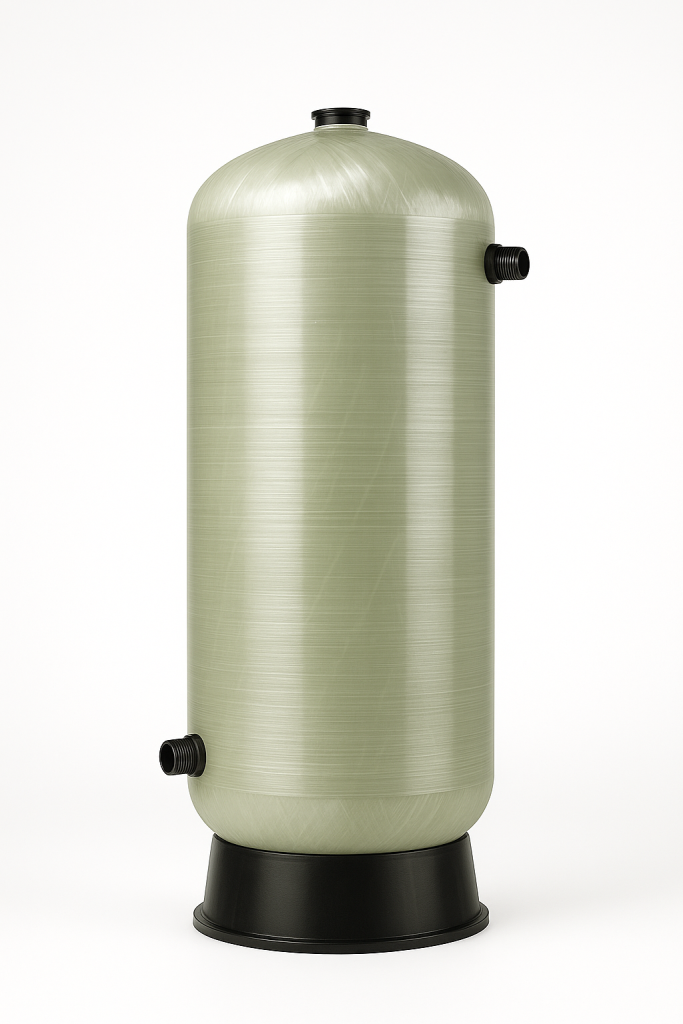FRP Tank for Industrial Wastewater Treatment



FRP Tank for Industrial Wastewater Treatment
Built to withstand the harsh demands of industrial wastewater systems, STARK’s vertical FRP tanks are engineered from high-strength fiberglass-reinforced plastic with optional anti-corrosive inner linings. Fully customizable in volume, structure, and chemical resistance, these tanks provide a reliable and cost-effective solution for storing or treating acidic, alkaline, or chemically contaminated water across diverse industrial sectors.
Built to withstand the harsh demands of industrial wastewater systems, STARK’s vertical FRP tanks are engineered from high-strength fiberglass-reinforced plastic with optional anti-corrosive inner linings. Fully customizable in volume, structure, and chemical resistance, these tanks provide a reliable and cost-effective solution for storing or treating acidic, alkaline, or chemically contaminated water across diverse industrial sectors.
STARK’s FRP tanks are engineered to meet the rigorous demands of industrial wastewater treatment applications. Manufactured using a combination of high-strength fiberglass reinforcement and corrosion-resistant resin systems, these tanks offer excellent structural performance, chemical durability, and a long service life in aggressive environments.
Our tanks are produced via precision filament winding or hand lay-up processes, ensuring consistent wall thickness, seamless fabrication, and uniform resin distribution. This production approach provides superior mechanical stability compared to conventional plastic or steel tanks in corrosive environments.
Corrosion-Resistant Inner Linings
The internal surface of each FRP tank can be lined with application-specific materials based on the chemical composition of the wastewater, such as:
- Epoxy Resin: Excellent chemical resistance for acidic and mildly alkaline wastewater.
- Vinyl Ester Resin: Ideal for solvents, chlorine-rich liquids, and high-temperature effluent conditions.
- Rubber or Polypropylene (PP) Linings: Suitable for extreme chemical environments such as plating, battery, or dyeing wastewater treatment.
Robust Structural Configuration
- Vertical cylindrical structure as standard; horizontal and rectangular versions available on request.
- Reinforced dome heads and stiffener rings to support hydrostatic pressure and prevent wall deformation under liquid load.
- UV-resistant exterior topcoat ensures outdoor durability without performance degradation.
- Integrated nozzles with full-face flanges or threaded ends, reinforced to handle flow and vibration stress.
- Anti-leak manholes with chemical-grade gaskets and anti-corrosion fastening hardware.
Customization Options
Each FRP tank can be tailored to suit customer-specific process and layout requirements:
- Volume: 1,000L to 100,000L+ with optional baffling for fluid control
- Wall thickness: Optimized for pressure (0.1–0.6 MPa) and fluid density
- Nozzle sizes and locations: Based on inlet/outlet configuration, cleaning access, or level sensors
- Foundation types: Skirt, ring base, concrete pad, or anti-slip steel support
- Instrumentation ports: For level indicators, overflows, manometers, pH/ORP probes
Certifications and Testing
STARK FRP tanks conform to key international and regional standards such as:
- ASME RTP-1 (Reinforced Thermoset Plastic Vessels)
- BS EN 13121 (European GRP tank standard)
- GB/T 27546-2011 (China FRP storage tank standard)
Each unit undergoes hydrostatic pressure testing, dimensional and visual inspection, and optional spark testing for lining integrity.
Typical wastewater types supported include acidic pickling solutions, alkaline degreasers, heavy metal-laden effluent, COD/BOD-rich organic water, and recycled greywater. Our tanks are widely deployed in electroplating, textile dyeing, paper manufacturing, chemical blending, food processing, and landfill leachate treatment facilities.
| Parameter | Specification |
|---|---|
| Tank Type | Vertical FRP cylindrical tank (horizontal optional) |
| Volume Capacity | 1,000L – 100,000L (fully customizable) |
| Shell Material | Fiberglass reinforced plastic (FRP) with UV-resistant topcoat |
| Inner Lining | Epoxy, vinyl ester, rubber, PP (based on chemical compatibility) |
| Wall Thickness | 6 mm – 25 mm (dependent on pressure, height, and diameter) |
| Design Pressure | 0.1 MPa – 0.6 MPa (hydrostatic tested) |
| Operating Temperature | -10°C to +90°C (up to 120°C with special resin systems) |
| Nozzle Connections | Flanged (ANSI/DIN), threaded, or sealed blind ports |
| Manhole | Top-mounted or side-access; bolted or hinged; gasketed |
| Foundation Options | Flat base, skirt support, concrete ring base, or steel frame |
| Inspection Ports | Optional level gauges, overflow lines, pH probe mounts |
| Certifications | ASME RTP-1, EN 13121, GB/T 27546 (optional upon request) |
Note: All parameters can be adjusted to meet your wastewater characteristics, local regulations, and engineering layout. For technical drawings or project-based solutions, contact our team.
STARK’s FRP tanks are integral to a wide range of industrial wastewater treatment processes, where long-term exposure to corrosive, chemically unstable, or high-volume fluids presents a challenge for traditional materials. With superior anti-corrosion performance and structural flexibility, FRP tanks are a preferred solution for storage, regulation, and conditioning of wastewater across various industries.
Common Use Cases in Wastewater Processes
- Equalization Tanks: Installed at the front-end of wastewater treatment systems to regulate flow rate and homogenize influent quality, minimizing load fluctuations to downstream biological or chemical reactors.
- Neutralization and pH Adjustment Tanks: Used for acid-alkali reaction balancing by adding neutralizing agents. Typical in metal surface treatment and semiconductor manufacturing wastewater.
- Coagulation and Flocculation Holding: Acts as a mixing chamber for dosing PAC/PAM or other flocculants prior to sedimentation units.
- Settling and Clarification Tanks: Temporarily store wastewater after initial solid separation stages, often lined with reinforced bottom drain structures to manage sludge residue.
- Chemical Storage Tanks: Store highly reactive dosing chemicals such as sodium hypochlorite, sulfuric acid, hydrochloric acid, or caustic soda in pre-treatment stations.
- Disinfection Water Buffering: Store post-chlorination water prior to final discharge or reuse in graywater systems.
- Concentrate & Brine Collection: Used to temporarily hold reject streams from RO systems, zero-liquid discharge (ZLD) processes, or evaporation units.
Typical Industry Applications
- Electroplating and Metal Finishing: Handles wastewater with high concentrations of chromium, nickel, and acidic pH—requiring chemical-resistant tank interiors.
- Textile and Dyeing Industry: Stores color-rich, surfactant-laden wastewater from dye baths and washing lines. Often integrated with flow-equalization and BOD/COD balancing systems.
- Pharmaceutical Manufacturing: Collects process water with solvents and bioactive compounds that require controlled neutralization and containment.
- Paper and Pulp Industry: Used in large-volume applications for fiber-rich effluent, with optional sludge cone bottoms for solids separation efficiency.
- Petrochemical Facilities: Stores high-temperature and oil-contaminated wastewater from cooling towers, refinery operations, or desalter units.
- Landfill Sites & Leachate Stations: FRP tanks are ideal for long-term leachate collection due to their resistance to organic acids and ammoniacal nitrogen compounds.
- Mining and Smelting: Holds acidic drainage containing heavy metals such as arsenic, cadmium, and mercury, especially in open-pit or underground mine wastewater systems.
These tanks can be installed as standalone units or integrated into modular containerized wastewater treatment plants (WWTPs). Their lightweight design reduces civil construction costs, while their long service life and minimal maintenance requirements make them an ideal choice for both new installations and retrofitting projects.
STARK’s FRP tanks are engineered to meet the rigorous demands of industrial wastewater treatment applications. Manufactured using a combination of high-strength fiberglass reinforcement and corrosion-resistant resin systems, these tanks offer excellent structural performance, chemical durability, and a long service life in aggressive environments.
Our tanks are produced via precision filament winding or hand lay-up processes, ensuring consistent wall thickness, seamless fabrication, and uniform resin distribution. This production approach provides superior mechanical stability compared to conventional plastic or steel tanks in corrosive environments.
Corrosion-Resistant Inner Linings
The internal surface of each FRP tank can be lined with application-specific materials based on the chemical composition of the wastewater, such as:
- Epoxy Resin: Excellent chemical resistance for acidic and mildly alkaline wastewater.
- Vinyl Ester Resin: Ideal for solvents, chlorine-rich liquids, and high-temperature effluent conditions.
- Rubber or Polypropylene (PP) Linings: Suitable for extreme chemical environments such as plating, battery, or dyeing wastewater treatment.
Robust Structural Configuration
- Vertical cylindrical structure as standard; horizontal and rectangular versions available on request.
- Reinforced dome heads and stiffener rings to support hydrostatic pressure and prevent wall deformation under liquid load.
- UV-resistant exterior topcoat ensures outdoor durability without performance degradation.
- Integrated nozzles with full-face flanges or threaded ends, reinforced to handle flow and vibration stress.
- Anti-leak manholes with chemical-grade gaskets and anti-corrosion fastening hardware.
Customization Options
Each FRP tank can be tailored to suit customer-specific process and layout requirements:
- Volume: 1,000L to 100,000L+ with optional baffling for fluid control
- Wall thickness: Optimized for pressure (0.1–0.6 MPa) and fluid density
- Nozzle sizes and locations: Based on inlet/outlet configuration, cleaning access, or level sensors
- Foundation types: Skirt, ring base, concrete pad, or anti-slip steel support
- Instrumentation ports: For level indicators, overflows, manometers, pH/ORP probes
Certifications and Testing
STARK FRP tanks conform to key international and regional standards such as:
- ASME RTP-1 (Reinforced Thermoset Plastic Vessels)
- BS EN 13121 (European GRP tank standard)
- GB/T 27546-2011 (China FRP storage tank standard)
Each unit undergoes hydrostatic pressure testing, dimensional and visual inspection, and optional spark testing for lining integrity.
Typical wastewater types supported include acidic pickling solutions, alkaline degreasers, heavy metal-laden effluent, COD/BOD-rich organic water, and recycled greywater. Our tanks are widely deployed in electroplating, textile dyeing, paper manufacturing, chemical blending, food processing, and landfill leachate treatment facilities.
| Parameter | Specification |
|---|---|
| Tank Type | Vertical FRP cylindrical tank (horizontal optional) |
| Volume Capacity | 1,000L – 100,000L (fully customizable) |
| Shell Material | Fiberglass reinforced plastic (FRP) with UV-resistant topcoat |
| Inner Lining | Epoxy, vinyl ester, rubber, PP (based on chemical compatibility) |
| Wall Thickness | 6 mm – 25 mm (dependent on pressure, height, and diameter) |
| Design Pressure | 0.1 MPa – 0.6 MPa (hydrostatic tested) |
| Operating Temperature | -10°C to +90°C (up to 120°C with special resin systems) |
| Nozzle Connections | Flanged (ANSI/DIN), threaded, or sealed blind ports |
| Manhole | Top-mounted or side-access; bolted or hinged; gasketed |
| Foundation Options | Flat base, skirt support, concrete ring base, or steel frame |
| Inspection Ports | Optional level gauges, overflow lines, pH probe mounts |
| Certifications | ASME RTP-1, EN 13121, GB/T 27546 (optional upon request) |
Note: All parameters can be adjusted to meet your wastewater characteristics, local regulations, and engineering layout. For technical drawings or project-based solutions, contact our team.
STARK’s FRP tanks are integral to a wide range of industrial wastewater treatment processes, where long-term exposure to corrosive, chemically unstable, or high-volume fluids presents a challenge for traditional materials. With superior anti-corrosion performance and structural flexibility, FRP tanks are a preferred solution for storage, regulation, and conditioning of wastewater across various industries.
Common Use Cases in Wastewater Processes
- Equalization Tanks: Installed at the front-end of wastewater treatment systems to regulate flow rate and homogenize influent quality, minimizing load fluctuations to downstream biological or chemical reactors.
- Neutralization and pH Adjustment Tanks: Used for acid-alkali reaction balancing by adding neutralizing agents. Typical in metal surface treatment and semiconductor manufacturing wastewater.
- Coagulation and Flocculation Holding: Acts as a mixing chamber for dosing PAC/PAM or other flocculants prior to sedimentation units.
- Settling and Clarification Tanks: Temporarily store wastewater after initial solid separation stages, often lined with reinforced bottom drain structures to manage sludge residue.
- Chemical Storage Tanks: Store highly reactive dosing chemicals such as sodium hypochlorite, sulfuric acid, hydrochloric acid, or caustic soda in pre-treatment stations.
- Disinfection Water Buffering: Store post-chlorination water prior to final discharge or reuse in graywater systems.
- Concentrate & Brine Collection: Used to temporarily hold reject streams from RO systems, zero-liquid discharge (ZLD) processes, or evaporation units.
Typical Industry Applications
- Electroplating and Metal Finishing: Handles wastewater with high concentrations of chromium, nickel, and acidic pH—requiring chemical-resistant tank interiors.
- Textile and Dyeing Industry: Stores color-rich, surfactant-laden wastewater from dye baths and washing lines. Often integrated with flow-equalization and BOD/COD balancing systems.
- Pharmaceutical Manufacturing: Collects process water with solvents and bioactive compounds that require controlled neutralization and containment.
- Paper and Pulp Industry: Used in large-volume applications for fiber-rich effluent, with optional sludge cone bottoms for solids separation efficiency.
- Petrochemical Facilities: Stores high-temperature and oil-contaminated wastewater from cooling towers, refinery operations, or desalter units.
- Landfill Sites & Leachate Stations: FRP tanks are ideal for long-term leachate collection due to their resistance to organic acids and ammoniacal nitrogen compounds.
- Mining and Smelting: Holds acidic drainage containing heavy metals such as arsenic, cadmium, and mercury, especially in open-pit or underground mine wastewater systems.
These tanks can be installed as standalone units or integrated into modular containerized wastewater treatment plants (WWTPs). Their lightweight design reduces civil construction costs, while their long service life and minimal maintenance requirements make them an ideal choice for both new installations and retrofitting projects.














